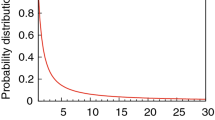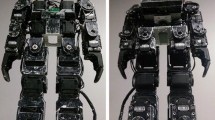Abstract
Multi-robot systems are frequently used for tasks involving searching, so it is important to be able to estimate the searching time. Yet, simulation approaches and real-world experiments to determine searching time can be cumbersome and even impractical. In this work, we propose a correlated-random-walk based model to efficiently approximate hitting time distributions of multi-robot systems in large arenas. We verified the computational results by using ARGoS, a physics-based simulator. We found that the Gamma distribution can provide a good fit to the hitting time distributions of random walkers.
Access this chapter
Tax calculation will be finalised at checkout
Purchases are for personal use only
Similar content being viewed by others
References
Alon, N., Avin, C., Kouckỳ, M., Kozma, G., Lotker, Z., Tuttle, M.R.: Many random walks are faster than one. Comb. Probab. Comput. 20(4), 481–502 (2011)
Barlow, M.T., Peres, Y., Sousi, P.: Collisions of random walks. Ann. l’IHP Probab. Stat. 48(4), 922–946 (2012)
Besenczi, R., Bátfai, N., Jeszenszky, P., Major, R., Monori, F., Ispány, M.: Large-scale simulation of traffic flow using Markov model. PLOS One 16(2) (2021)
Boley, D.: On fast computation of directed graph Laplacian pseudo-inverse. Linear Algebra Appl. 623, 128–148 (2021)
Boley, D., Ranjan, G., Zhang, Z.L.: Commute times for a directed graph using an asymmetric Laplacian. Linear Algebra Appl. 435(2), 224–242 (2011)
Brightwell, G., Winkler, P.: Maximum hitting time for random walks on graphs. Random Struct. Algorithms 1(3), 263–276 (1990)
Codling, E.A., Bearon, R.N., Thorn, G.J.: Diffusion about the mean drift location in a biased random walk. Ecology 91(10), 3106–3113 (2010)
Codling, E.A., Plank, M.J., Benhamou, S.: Random walk models in biology. J. R. Soc. Interface 5(25), 813–834 (2008)
Dayar, T., Akar, N.: Computing moments of first passage times to a subset of states in Markov chains. SIAM J. Matrix Anal. 27(2), 396–412 (2005)
Dimidov, C., Oriolo, G., Trianni, V.: Random walks in swarm robotics: an experiment with kilobots. In: International Conference on Swarm Intelligence, pp. 185–196. Springer, Berlin (2016)
Efremenko, K., Reingold, O.: How well do random walks parallelize? In: Dinur, I., Jansen, K., Naor, S., Rolim, J. (eds.) Approximation, Randomization, and Combinatorial Optimization. Algorithms and Techniques, vol. 5687. Springer, Berlin (2009)
Gaudillière, A.: Collision probability for random trajectories in two dimensions. Stoch. Process. Appl. 119(3), 775–810 (2009)
Grinstead, C.M., Snell, J.L.: Introduction to Probability. American Mathematical Society (1997)
Hamann, H.: Modeling swarm systems and formal design methods. In: Swarm Robotics: A Formal Approach, pp. 95–127. Springer, Berlin (2018)
Hill, N., Häder, D.P.: A biased random walk model for the trajectories of swimming micro-organisms. J. Theor. Biol. 186(4), 503–526 (1997)
Jeong, M., Harwell, J., Gini, M.: Analysis of exploration in swarm robotic systems. IAS-16 (2021)
Kemeny, J.G., Snell, J.L.: Finite Markov Chains. Springer, Berlin (1976)
Khalastchi, E., Kalech, M.: Fault detection and diagnosis in multi-robot systems: a survey. Sensors 19(18) (2019)
Lancaster, J.P., Gustafson, D.A.: Predicting the behavior of robotic swarms in search and tag tasks. Procedia Comput. Sci. 20, 77–82 (2013)
Lau, H.W., Szeto, K.Y.: Asymptotic analysis of first passage time in complex networks. EPL (Europhys. Lett.) 90(4), 40005 (2010)
Lovász, L.: Random walks on graphs. Combinatorics 2(1–46), 4 (1993)
Masuda, N., Porter, M.A., Lambiotte, R.: Random walks and diffusion on networks. Phys. Rep. 716, 1–58 (2017)
Morgan, R.B.: GMRES with deflated restarting. SIAM J. Sci. Comput. 24(1), 20–37 (2002)
Nain, R., Sen, K.: Transition probability matrices for correlated random walks. J. Appl. Probab. 17(1), 253–258 (1980)
Patel, R., Carron, A., Bullo, F.: The hitting time of multiple random walks. SIAM J. Matrix Anal. 37(3), 933–954 (2016)
Pinciroli, C., Trianni, V., O’Grady, R., Pini, G., Brutschy, A., Brambilla, M., Mathews, N., Ferrante, E., Di Caro, G., Ducatelle, F., et al.: ARGoS: a modular, multi-engine simulator for heterogeneous swarm robotics. In: IEEE/RSJ International Conference on Intelligent Robots and Systems, pp. 5027–5034. IEEE (2011)
Acknowledgements
This research was partially supported by the University of Minnesota Robotics Institute.
Author information
Authors and Affiliations
Corresponding author
Editor information
Editors and Affiliations
Rights and permissions
Copyright information
© 2023 The Author(s), under exclusive license to Springer Nature Switzerland AG
About this paper
Cite this paper
Zhang, Y., Boley, D., Harwell, J., Gini, M. (2023). A Correlated Random Walk Model to Rapidly Approximate Hitting Time Distributions in Multi-robot Systems. In: Petrovic, I., Menegatti, E., Marković, I. (eds) Intelligent Autonomous Systems 17. IAS 2022. Lecture Notes in Networks and Systems, vol 577. Springer, Cham. https://doi.org/10.1007/978-3-031-22216-0_48
Download citation
DOI: https://doi.org/10.1007/978-3-031-22216-0_48
Published:
Publisher Name: Springer, Cham
Print ISBN: 978-3-031-22215-3
Online ISBN: 978-3-031-22216-0
eBook Packages: Intelligent Technologies and RoboticsIntelligent Technologies and Robotics (R0)




